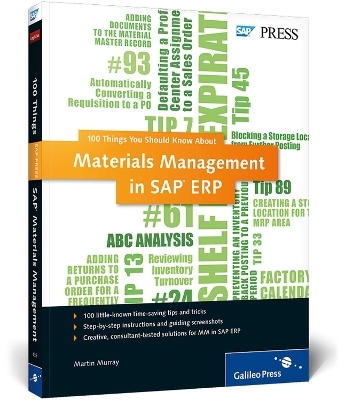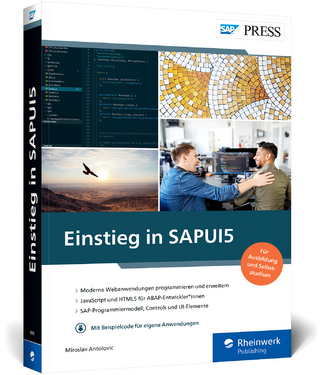
Materials Management in SAP ERP
SAP Press (Verlag)
978-1-59229-438-1 (ISBN)
- Titel ist leider vergriffen;
keine Neuauflage - Artikel merken
Master data
Planning
Inventory management
Purchasing
Configuration
Scheduling
Warehousing
Invoicing
A native of London, England, Martin Murray joined the computer industry upon his graduation from Middlesex University in 1986. In 1991, he began working with SAP R/2 in the Materials Management area for a London-based multi-national beverage company. In 1994, he moved to the United States to work as an SAP R/3 consultant. Since then, he's been implementing the Materials Management (MM) and Warehouse Management (WM) functionality in projects throughout the world. He works for IBM Global Business Services.Martin is the author of six best-selling books from SAP PRESS: Materials Management with SAP ERP, Warehouse Management with SAP ERP, Discover Logistics with SAP ERP, Maximize Your Warehouse Operations with SAP ERP, Understanding the SAP Logistics Information System, and SAP Transaction Codes: Your Quick Reference to T-Codes in SAP ERP.
Introduction
PART 1. Master Data
Extending Materials for Additional Views
Deactivating a Vendor
Deleting an Obsolete Material
Changing the Price of a Material
Changing a Material's Base Unit of Measure
Changing the Valuation Class in the Material Master
Changing the Moving Average Price for a Material
Manually Entering a Safety Stock Value in the Material Master
Setting Up Automatic Creation for the Storage Location Data of a Material
Creating Default Storage Locations in Production
Blocking Sales Orders for a Material from Being Created
Defaulting a Profit Center Assignment to a Sales Order
Working with the Availability Check Scope
Using Material Master User Exits to Create a New Material
Adding Documents to the Material Master Record
PART 2. Purchasing
Reversing a Goods Receipt after an Invoice
Blocking a Vendor
Creating a Purchase Order for a Material with No Price
Adding an Attachment to a Purchase Order
Adding Returns to a Purchase Order for a Frequently Used Vendor
Defaulting the Last Purchase Order Price for the Material
Configuring Purchase Order Conditions to Reflect the Correct Material Price
Automatically Default Purchase Order Text
Maintaining Purchase Orders en Masse
Maintaining Purchase Requisitions en Masse
Setting Up Vendor Free Goods on the Purchase Order
Copying Purchase Requisition Text to a Complete PO
Identifying Inactive Vendors by Period
Editing Configuration Fields to Generate a Purchase Order Reprint
Automatically Converting a Requisition to a PO
Posting Invoices en Masse
Choosing Vendors by Analyzing Vendor Evaluation Reports
Understanding the Confirmation Control Key
Configuring Automatic Purchase Order Creation during Goods Receipt
Changing the Purchase Order List Display
Skipping Inspection for Vendors
Defining Standard Details of Forms for Company Codes
Limiting a User's Authorization to Create Purchase Orders
Creating a One-Time Vendor
Assigning a Reference Purchasing Organization to a Local Level
PART 3. Inventory Management
Manually Blocking a Storage Location
Blocking Materials from Inventory Posting
Blocking a Storage Location from Further Posting
Preventing an Inventory Back Posting to a Previous Period
Performing Month-End Closing
Performing Year-End Closing
Enabling the Use of Negative Stocks
Using Change Records to Formally Monitor and Document Changes
Configuring Criteria and Cycle Counts for ABC Analysis
Changing the Level of Inventory Management System Messages
Adding Multiple Manufacturer Part Numbers to a Material
Performing a Goods Receipt without Delivery
Processing Mass Changes to Multiple Batches
Setting Up Split Valuation with Batches
Creating a System Check for the Shelf Life Expiration Date
Configuring the Reversal of Goods Receipt after Invoice
Activating Storage Location Authorization
Processing a Free-of-Charge Delivery
Reviewing Inventory Turnover
Clearing Differences between Inventory and Warehouse Management Inventories
Setting Up Early Warnings to Improve Warehouse Efficiency
Re-Opening a Period Closing to Make a Change
Creating Automatic Scheduling Agreement Lines
Changing the Layout of the Stock Overview Report
Resetting Count Totals to Zero in Count Documents
Setting Up an Alternative Unit of Measure for a Material
193 67
19568
19869
20170
20471
20772
20973
21374
21575
21876
22177
22478
22779
23080
23381
23582
238 PART 5. Configuration
Creating a New Movement Type by Copying an Existing Movement Type
Deactivating Standard Movement Types
Configuring the System to Allow Consignment Stock
Creating a New Purchase Order Document Type to Establish Different Purchases
Configuring the System to Assign a Valuation Class to a Specific Material Group
Freezing Stock for a Physical Inventory Count
Creating Views for User Groups in the Batch Information Cockpit
Restricting Batches for Batch Determination
Configuring Time-Based Material Substitution
Excluding Materials from Being Sold to Certain Customers
Scheduling the Period Close to Run Automatically with Dynamic Variation
Maintaining the GR/IR Account to Process Variances
Editing the Field Display in the Service Master Record
Defining Default Values for Buyers in Common Documents
Configuring Non-Standard Payment Terms After Negotiation
Setting Up Different Numbering Schemas for Material Types
Configuring the Views in the Plant-Specific Material Master
Manually Creating an Inspection Lot
293 Materials Management Transaction Codes
307 Index ... 309
| Erscheint lt. Verlag | 25.2.2013 |
|---|---|
| Reihe/Serie | SAP PRESS Englisch |
| Verlagsort | Maryland |
| Sprache | englisch |
| Maße | 175 x 229 mm |
| Themenwelt | Mathematik / Informatik ► Informatik ► Netzwerke |
| Informatik ► Weitere Themen ► SAP | |
| Wirtschaft ► Betriebswirtschaft / Management ► Logistik / Produktion | |
| ISBN-10 | 1-59229-438-3 / 1592294383 |
| ISBN-13 | 978-1-59229-438-1 / 9781592294381 |
| Zustand | Neuware |
| Informationen gemäß Produktsicherheitsverordnung (GPSR) | |
| Haben Sie eine Frage zum Produkt? |
aus dem Bereich


